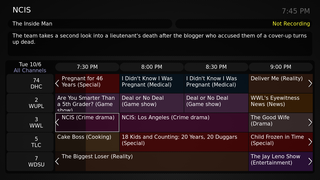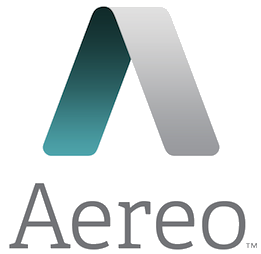Related Research Articles

TiVo is a digital video recorder (DVR) developed and marketed by Xperi and introduced in 1999. TiVo provides an on-screen guide of scheduled broadcast programming television programs, whose features include "OnePass" schedules which record every new episode of a series, and "WishList" searches which allow the user to find and record shows that match their interests by title, actor, director, category, or keyword. TiVo also provides a range of features when the TiVo DVR is connected to a home network, including film and TV show downloads, advanced search, personal photo viewing, music offerings, and online scheduling.

Video on demand (VOD) is a media distribution system that allows users to access videos without a traditional video playback device and the constraints of a typical static broadcasting schedule. In the 20th century, broadcasting in the form of over-the-air programming was the most common form of media distribution. As Internet and IPTV technologies continued to develop in the 1990s, consumers began to gravitate towards non-traditional modes of content consumption, which culminated in the arrival of VOD on televisions and personal computers.
ReplayTV was a brand of digital video recorder (DVR), a term synonymous with personal video recorder (PVR). It is a consumer video device which allows users to capture television programming to internal hard disk storage for later viewing. The first ReplayTV model was introduced in January 1999 during the Consumer Electronics Show in Las Vegas, at the same time as a competing DVR model from rival company TiVo. After the sale of assets to DirecTV, ReplayTV's only ongoing activity was maintenance of the electronic program guide service by D&M Holdings, which was to be discontinued on July 31, 2011. However, on July 29, 2011, a notice was placed on the ReplayTV website stating that service would be continued without interruption for lifetime subscribers and monthly subscribers may have a short interruption in service. On September 2, 2011, programming contact through the ReplayTV dialup system was terminated without any update message being sent to subscribers or posted on replaytv.com. DNNA filed for bankruptcy on July 20, 2015. EPG data from their servers ran out on July 15, 2015. Even with the end of support from DNNA, third-party solutions are available to provide Electronic Program Guide data to Replays.
A digital video recorder (DVR) is an electronic device that records video in a digital format to a disk drive, USB flash drive, SD memory card, SSD or other local or networked mass storage device. The term includes set-top boxes with direct to disk recording, portable media players and TV gateways with recording capability, and digital camcorders. Personal computers are often connected to video capture devices and used as DVRs; in such cases the application software used to record video is an integral part of the DVR. Many DVRs are classified as consumer electronic devices; such devices may alternatively be referred to as personal video recorders (PVRs), particularly in Canada. Similar small devices with built-in displays and SSD support may be used for professional film or video production, as these recorders often do not have the limitations that built-in recorders in cameras have, offering wider codec support, the removal of recording time limitations and higher bitrates.

A home theater PC (HTPC) or media center computer is a convergent device that combines some or all the capabilities of a personal computer with a software application that supports video, photo, audio playback, and sometimes video recording functionality. In recent years, other types of consumer electronics, including game consoles and dedicated media devices, have crossed over to manage video and music content. The term "media center" also refers to specialized application software designed to run on standard personal computers.

Electronic programming guides (EPGs) and interactive programming guides (IPGs) are menu-based systems that provide users of television, radio and other media applications with continuously updated menus that display scheduling information for current and upcoming broadcast programming. Some guides also feature backward scrolling to promote their catch up content. They are commonly known as guides or TV guides.
Performing rights are the right to perform music in public. It is part of copyright law and demands payment to the music's composer/lyricist and publisher. Performances are considered "public" if they take place in a public place and the audience is outside of a normal circle of friends and family, including concerts nightclubs, restaurants etc. Public performance also includes broadcast and cable television, radio, and any other transmitted performance of a live song.
The Nextcom R5000-HD is a popular Windows-based system for digitally capturing HD (high-definition) and SD (standard-definition) TV content from satellite TV and cable TV sources. A modification is required to the set-top box, giving it a USB 2.0 output that is connected to a PC. The digital video recorder (DVR) and companion personal video recorder (PVR) software runs on any Windows 2000, Windows XP, Windows 7 and Windows 10 system and can record just about any content to hard disk or D-VHS tape. Programming can be encoded in MPEG-2, or MPEG-4 type AVC/H.264 formats. MPEG transport streams compliant with the ISO 13818-1 specification are created.
This is a comparison of digital video recorder (DVR), also known as personal video recorder (PVR), software packages. Note: this is may be considered a comparison of DVB software, not all listed packages have recording capabilities.
TrueVisions is a cable and satellite television operator in Thailand. TrueVisions is owned by the True Corporation. Until February 2007, it was called the United Broadcasting Corporation (UBC), or UBC-True.
In broadcasting, time shifting is the recording of programming to a storage medium to be viewed or listened to after the live broadcasting. Typically, this refers to TV programming but it can also refer to radio shows via podcasts.

Cartoon Network, LP v. CSC Holdings, Inc., 536 F.3d 121, was a United States Court of Appeals for the Second Circuit decision regarding copyright infringement in the context of digital video recorders. Among other reasons, it is notable for disagreeing with the Ninth Circuit's holding in MAI Systems Corp. v. Peak Computer, Inc., regarding whether a momentary data stream is a "copy."

IceTV is an Australian company providing an independently curated Electronic Program Guide (EPG) for digital free-to-air television. It also produces Smart Recording Software.

Aereo was a technology company based in New York City that allowed subscribers to view live and time-shifted streams of over-the-air television on Internet-connected devices. The service opened to customers in March 2012, and was backed by Barry Diller's IAC.

Hopper is a line of digital video recording (DVR) set-top boxes offered by the U.S. direct-broadcast satellite television provider Dish Network. First introduced at Consumer Electronics Show in January 2012, the Hopper was released in March 2012 as a component of the provider's whole-home DVR system, which networks the main Hopper unit with smaller "Joey" set-top boxes to form a client-server architecture.
Fox Broadcasting Co. v. Dish Network, LLC is a copyright case in which the United States District Court for the Central District of California, by granting partial summary judgment, denied most parts of the copyright claims presented by Fox Broadcasting Company (Fox) against Dish Network (Dish) for its service, a DVR-like device that allowed users to record programming that could be accessed later through any Internet-connected device. The service offered by Dish also allowed users to record any or all Fox's prime-time programs and to automatically skips commercials (AutoHop).
American Broadcasting Cos., Inc. v. Aereo, Inc, 573 U.S. 431 (2014), was a United States Supreme Court case. The Court ruled that the service provided by Aereo, allowing subscribers to view live and time-shifted streams of over-the-air television on Internet-connected devices, violated copyright laws.

A TV gateway is a television headend to a network UPnP router that receives live digital video broadcast (DVB) MPEG transport streams (channels) from terrestrial aerials, satellite dishes, or cable feeds and converts them into IP streams for distribution over an IP network.
InstantTV is a cloud software digital video recorder (DVR) operated by RecordTV Pte Ltd based in Singapore. The company was founded by Carlos Nicholas Fernandes in 2007 and previously offered services as RecordTV.com.
Carlos Nicholas Fernandes is an inventor, founder and CEO of InstantTV, a service that offers Cloud DVR.
References
- ↑ Cartoon Network LP, LLLP v. CSC Holdings, Inc., 536 F.3d 121 (2d Cir. 2008)
- ↑ Multichannel News 29.31 (August 11, 2008) p2.
- ↑ http://www.cms-lawnow.com/-/media/nabarro-olswang-pdfs/olswang_cloudpvr_v4.pdf?la=en&hash=C8BC35D0BA7986B3427A18B40E904D9C38C22E67 [ bare URL PDF ]
- ↑ "Archived copy". Archived from the original on 2018-04-07. Retrieved 2018-04-03.
{{cite web}}: CS1 maint: archived copy as title (link) - ↑ "Appeals court hits RecordTV's play button".
- ↑ "Carlos Fernandes".
- ↑ "The Patry Copyright Blog: The Singaporean Cablevision Case". 23 March 2010.
- ↑ http://www.wipo.int/edocs/mdocs/mdocs/en/wipo_reg_cr_sin_15/wipo_reg_cr_sin_15_t_18.pdf [ bare URL PDF ]